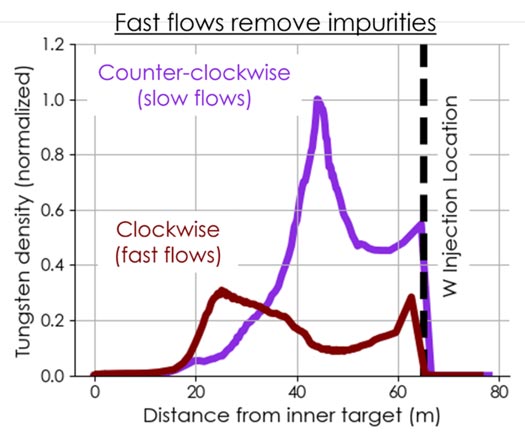Fast flows prevent buildup of impurities on the edge of tokamak plasmas

Simulation results showing tungsten density at the interface of the plasma’s edge and core for both magnetic field directions. Fast flows that often occur in the clockwise magnetic field direction reduce the accumulation of tungsten impurities.
Image courtesy of Shawn Zamperini, UT-Knoxville
New measurements show that fast flows in a tokamak plasma help remove and prevent impurities.
The Science
Impurities in the plasmas in fusion tokamaks can reduce performance. These impurities are created by interactions between the hot plasma and the metal tokamak walls. These walls are often armored with tungsten. This material resists heat, but degrades over time, releasing impurities into the plasma. Simulations predict how these impurities behave, but they are difficult to measure directly because many impurities only emit weak levels of radiation. The experiment detailed here used a collector probe to sample the plasma. It determined that detrimental impurities accumulate in the region just outside the plasma edge only when the tokamak magnetic fields rotate around the donut-shaped tokamak in a counter-clockwise direction. This is the opposite direction that the plasma current moves. Clockwise rotation causes fast flows that remove the impurities.
The Impact
Fusion power plants need plasmas that can maintain fusion conditions for long periods of time. Impurities in the plasma degrade performance. This means fusion science and technology researchers need to develop ways to control the transport of impurities through the plasma and remove them when they occur. This is important for practical fusion energy. Until now, there have been no experimental measurements of impurity accumulation in the important space between the tokamak’s metal wall and the edge of the plasma. This new research result suggests approaches that future power plants can use to prevent this accumulation.
Summary
In a tokamak, impurities can move through the edge of the plasma and enter the plasma’s core, contaminating it and reducing power. However, researchers do not fully understand impurity transport along the plasma edge. While simulations have predicted the accumulation of impurities in the plasma edge for decades, researchers have not obtained experimental evidence of this accumulation.
Researchers at the DIII-D National Fusion Facility, in partnership with the University of Tennessee, deployed a diagnostic called a collector probe to measure tungsten content in the edge of plasmas. They used the state-of-the-art edge simulation codes DIVIMP and 3DLIM to model impurity transport in the plasma edge. Simulations showed that in order to reproduce the experimental collector probe measurements, an accumulation must have occurred during the experiments. However, this accumulation only occurred when the tokamak’s magnetic field moved counter-clockwise. When the magnetic field moved clockwise, very fast plasma flows likely remove impurities and prevent their accumulation by transporting and depositing them on the vessel walls. These results appear to be the first indirect measurement of edge impurity accumulation ever made.
Funding
This material is based upon work supported by the Department of Energy (DOE) Office of Science, Office of Fusion Energy Sciences, using the DIII-D National Fusion Facility, a DOE Office of Science user facility.
Journal: Nuclear Materials and Energy
DOI: 10.1016/j.nme.2020.100811
Method of Research: Experimental study
Subject of Research: Not applicable
Article Title: Reproduction of collector probe deposition profiles using the far-SOL impurity transport code 3DLIM
Article Publication Date: 1-Dec-2020
Media Contact
Michael Church
DOE/US Department of Energy
michael.church@science.doe.gov
Office: 2028416299
Original Source
https://www.energy.gov/science/fes/articles/fast-flows-prevent-buildup-impurities-edge-tokamak-plasmas
All latest news from the category: Power and Electrical Engineering
This topic covers issues related to energy generation, conversion, transportation and consumption and how the industry is addressing the challenge of energy efficiency in general.
innovations-report provides in-depth and informative reports and articles on subjects ranging from wind energy, fuel cell technology, solar energy, geothermal energy, petroleum, gas, nuclear engineering, alternative energy and energy efficiency to fusion, hydrogen and superconductor technologies.
Newest articles

NASA: Mystery of life’s handedness deepens
The mystery of why life uses molecules with specific orientations has deepened with a NASA-funded discovery that RNA — a key molecule thought to have potentially held the instructions for…

What are the effects of historic lithium mining on water quality?
Study reveals low levels of common contaminants but high levels of other elements in waters associated with an abandoned lithium mine. Lithium ore and mining waste from a historic lithium…

Quantum-inspired design boosts efficiency of heat-to-electricity conversion
Rice engineers take unconventional route to improving thermophotovoltaic systems. Researchers at Rice University have found a new way to improve a key element of thermophotovoltaic (TPV) systems, which convert heat…



